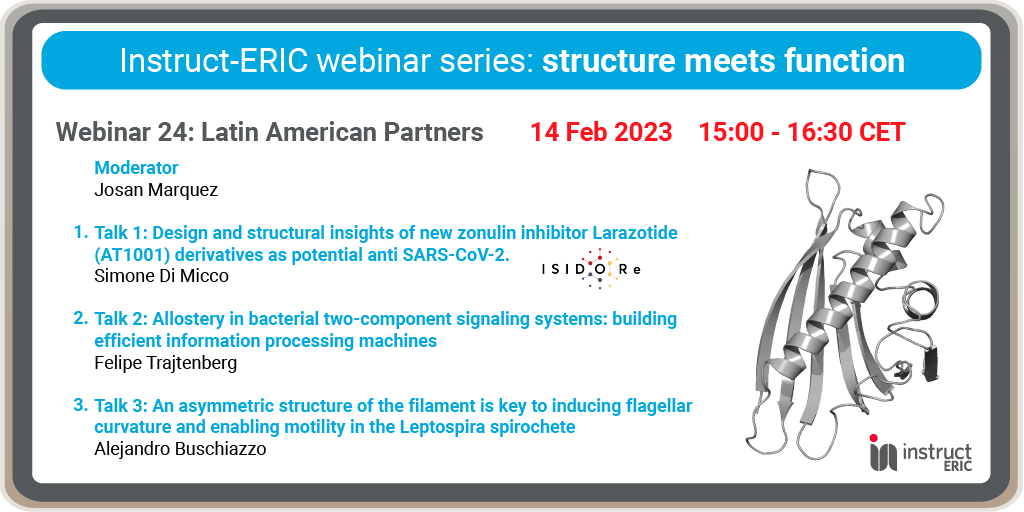February 14, 15:00 CET
The latest webinar in the Instruct-ERIC Structure Meets Function series will be a special edition. This month, guest speakers from Instruct’s partner institutions in Latin America will give talks on the work they completed as part of the International Call. Register for the webinar here.
Speaker Simone Di Micco (European Biomedical Research Institute of Salerno) will also be discussing their work through the ISIDORe project in his talk “Design and structural insights of new zonulin inhibitor Larazotide (AT1001) derivatives as potential anti SARS-CoV-2“. The project provided support from Instruct EMBL Facility in Grenoble.
Agenda:
Talk 1: Design and structural insights of new zonulin inhibitor Larazotide (AT1001) derivatives as potential anti SARS-CoV-2.
Speaker: Simone Di Micco
Associated Publication: “Rational design of the zonulin inhibitor AT1001 derivatives as potential anti SARS-CoV-2”
DOI:https://doi.org/10.1016/j.ejmech.2022.114857
Talk 2: Allostery in bacterial two-component signaling systems: building efficient information processing machines
Abstract: Information in two-component systems (TCSs) is transmitted through allosteric rearrangements and phosphoryl-transfer reactions. The sensory histidine kinase (HK) autophosphorylates, in a signal-dependent mechanism, a conserved histidine. Then, the phosphoryl-group is transferred to an invariant aspartate of the cognate response regulator (RR). Phosphoryl-transfer reactions can be evolutionary configured to be either uni- or bi-directional, a key feature to build highly complex regulatory networks. We have found that allostery is critical to tightly regulate phosphorylation and dephosphorylation activities and minimize back phosphoryl-transfer, ultimately guaranteeing efficient processing of the environmental information.
Speaker: Felipe Trajtenberg
Talk 3: An asymmetric structure of the filament is key to inducing flagellar curvature and enabling motility in the Leptospira spirochete
Abstract: Leptospirosis is a re-emerging zoonotic disease, with a burden of ~1 million cases and 50,000 deaths per year. Caused by several species of the genus Leptospira, these bacteria possess specially adapted flagella that remain confined within the periplasm (endoflagella). Endoflagella are efficient nanomachines, comprising ≳25 different types of proteins, essential for the fast corkscrew-like swimming and pathogenicity of leptospires. Little is known about the composition, function, and molecular architecture of endoflagellar filaments. Combining bacterial genetics, protein crystallography and cryo-electron microscopy/tomography, we have made significant progress in determining the 3D structures of complete Leptospira flagellar filament assemblies. These filaments comprise a protein core, coated by a highly asymmetric, multi-component sheath layer. Such asymmetric organization contrasts with the simple, flagellin-only architecture observed in exoflagellated bacteria. Detailed structural analyses of wild-type and mutant variants, disclose the mechanisms that underlie spontaneous filament supercoiling, a key feature for normal spirochete motility.
Speaker: Alejandro Buschiazzo
Find out more about Instruct-ERIC’s international collaboration here.
Take a look at the previous webinars in the series here.

